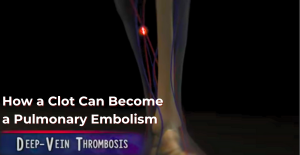
deep veins can cause a DVT.
A deep vein thrombosis (DVT) is a blood clot that forms in the deep veins of your legs, arms or pelvis. A DVT can be dangerous if it breaks off and travels to the lungs. This is known as a pulmonary embolism (PE) and can be life threatening. A DVT and a PE are collectively known as venous thromboembolism (VTE). VTE does not discriminate. It affects people of all ages and backgrounds, but more so in the elderly. It is important to know your risk and take steps to prevent VTE. You should know the signs and symptoms and seek medical care right away if you think you have a DVT or PE.
FACTS
VTE affects as many as 900,000 Americans each year and as many as 100,000 people die each year from blood clots. This is more deaths than breast cancer, HIV and motor vehicle crashes combined.
About one third (33%) of people with VTE will have a reoccurrence within 10 years. Half of the people with DVT will have long-term complications such as pain, swelling and skin changes in the affected leg.
1 in 4 people who have a PE die without warning. DVT and PE are often underdiagnosed. BUT...DVT and PE are preventable if you know your risk.
RISKS
Being inactive due to hospitalization, illness, travel in a car or airplane allows the blood to pool in your lower leg. This is an easy way for a clot to form.
Cancer, pregnancy, birth control, hormone replacements and smoking cause your blood to be sticky, which increases the chance of clot formation.
Surgery or trauma can cause the blood to clot because there is damage to the blood vessel and the body tries to fix it by using a clot to repair itself.
SYMPTOMS TO LOOK FOR
| PE Symptoms | DVT symptoms |
|
|
To diagnose a DVT, an ultrasound will be done to look at the blood flow in your leg veins.
To diagnose a PE, a CT scan with dye will be done to look at the blood flow in your lungs.
If you experience any symptoms of a PE it is important to seek medical attention immediately!
PREVENTION
Exercise regularly and maintain a healthy weight
If you are traveling, it is important that you walk every two hours. Wear loose fitting clothes and stay hydrated (no caffeine or alcohol).
Before and during a hospitalization, talk to your healthcare provider about your risk and what can be done to prevent blood clots. Move around in the bed as much as possible and get out of bed and walk when the practitioner says it's okay. You may be given a blood thinner (anticoagulant) while you are hospitalized. A mechanical compression device may be recommended. These are sleeves that are placed on your calf and squeeze from time to time to help the blood flow. It is important you keep these on unless you are walking.
Talk to your doctor about your level of risk! While we sincerely hope you or someone you love never experiences a DVT, it is important to know you have access to advanced treatment and expertise here at Stony Brook University Hospital. Our specially-trained, award-winning DVT team has reduced the amount of hospital-acquired DVTs. You can also receive outpatient care at our Centereach and Commack locations that specialize in veins for immediate and long-term management. The team is led by Angela Kokkosis, MD, Associate Professor of Surgery and member of our Vascular and Endovascular Surgery Division.
Learn more about DVT. For consultations/appointments with our vein specialists, please call the Center for Vein Care at 800-345-VEIN (8346).
VIDEO: How a Clot Can Become a Pulmonary Embolism


